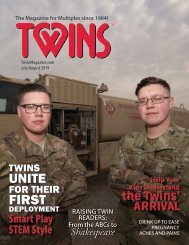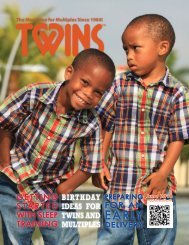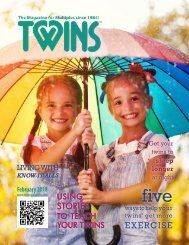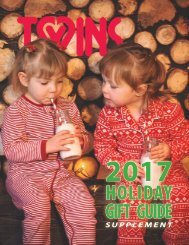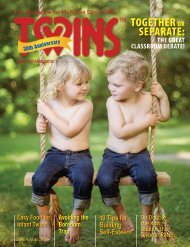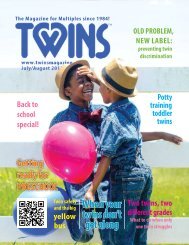2007GuideToTheFirstYear
Create successful ePaper yourself
Turn your PDF publications into a flip-book with our unique Google optimized e-Paper software.
The best way for delayed breastfeeding<br />
to be successful is for the mother to begin<br />
expressing her milk as soon as possible<br />
after their births, and to receive ongoing<br />
guidance from the hospital staff while<br />
the babies are in the NICU. After that,<br />
she should be counseled by a lactation<br />
consultant or similarly knowledgeable<br />
professional and other mothers when the<br />
babies come home. (See “Mothers Can<br />
Get Help!” on page 22)<br />
Options for feeding<br />
The American Academy of Pediatrics’<br />
Committee on Nutrition recommends as<br />
first choice the mother’s own fresh unprocessed<br />
milk for a premature baby. The milk<br />
of a mother who has delivered prematurely<br />
is different from the milk of a mother who<br />
carries her babies to full-term. So-called<br />
“preterm milk” is actually higher in certain<br />
nutrients such as protein, sodium, calcium,<br />
iron and chloride, and therefore more suited<br />
to the needs of premature babies.<br />
Infection-fighting antibodies are also<br />
higher in preterm milk, which is important<br />
since premature infants are more<br />
susceptible to infection. Donor milk, during<br />
pasteurization, loses some of the live<br />
cells that fight infection. Extremely early,<br />
small babies who are born prematurely<br />
can receive breast milk. Even the colostrums—<br />
a mother’s clear, yellow-colored<br />
early breastmilk available immediately<br />
after birth—is high in protein and certain<br />
immunologic factors and should be<br />
expressed to save for when the babies are<br />
ready.<br />
Considered next best is frozen breastmilk,<br />
expressed by the mother and stored<br />
under proper conditions (see “Storing<br />
Breastmilk” on this page), followed<br />
by donor human milk. Donor milk is<br />
mature breastmilk that has been donated<br />
by other breastfeeding mothers. It is usually<br />
pasteurized, so it lacks some of the<br />
advantages of fresh preterm milk. Even<br />
so, it is still considered superior to formula<br />
because it is easier to digest, helping<br />
babies avoid bowel problems, to which<br />
premature infants are prone.<br />
Special formulas designed specifically<br />
for preemies are available and can be used<br />
alone or mixed with human breastmilk if<br />
the mother’s own supply is inadequate.<br />
The AAP recommends that formula be<br />
Advantages of Breastfeeding<br />
Premature Twins<br />
1Human breastmilk is easier to digest<br />
and better tolerated by most premature<br />
infants than formula. Proteins in<br />
human milk—unlike proteins in formulas—are<br />
completely broken down<br />
and absorbed by the human digestive<br />
system.<br />
2An enzyme, lipase, helps babies digest<br />
milkfat more efficiently and is<br />
contained in human breastmilk. Fat is an<br />
important source of energy for premature<br />
babies’ growth.<br />
3Human milk contains extra defenses<br />
against infection. Antibodies give a<br />
premature baby’s immature immune<br />
system protection from potentially serious<br />
bacterial and viral infections.<br />
Storing Breastmilk<br />
When preemies are in the neonatal intensive<br />
care unit (NICU), before they’re able to feed<br />
orally on a regular basis, a breastfeeding<br />
mother must store her expressed milk. Some<br />
nutrients (fat, and antibodies) are thought to<br />
cling to the inside surfaces of the storage containers,<br />
whether glass, hard or soft plastic.<br />
The container chosen should be sterile or<br />
as clean as possible. To sterilize, rinse the<br />
container with boiling water before using it.<br />
Check with a lactation consultant or NICU staff<br />
member about the appropriate container to<br />
use, because the choice depends on the age<br />
and condition of the baby. The smaller the<br />
baby, the more precise the calibrations must<br />
be on their feeders. Additionally, the sucking<br />
ability of the baby must be considered.<br />
Freezing destroys some live cells present in<br />
the miIk, but still offers the next best protection<br />
to fresh milk.<br />
Many moms use 4-oz. sterile water bottles<br />
or hard plastic 2-oz. volufeeders (tiny,<br />
calibrated bottles that make precise feeding<br />
amounts easier to measure) available in the<br />
NICU nursery. Or you can use soft plastic bottle<br />
liners available in most drug/discount stores.<br />
The bottle liners are clearly the cheapest,<br />
most convenient to obtain and most popular.<br />
However, they have the following disadvantages:<br />
Removing air prior to freezing may<br />
cause contents to spill; seams may burst during<br />
freezing (double-bagging helps avoid this);<br />
4Research suggests that human milk<br />
contains hormones and enzymes,<br />
including certain growth factors important<br />
to your twins’ maturity, digestive<br />
and nervous systems.<br />
5Breastfeeding helps bring moms and<br />
their babies closer. Even before<br />
actually breastfeeding, twins can be fed<br />
their mother’s milk by tube. This can<br />
help mom feel “connected” to her infants<br />
even before she can care directly for her<br />
children.<br />
Source: Breastfeeding Answer Book (La<br />
Leche International, Franklin Park, IL,<br />
2003)<br />
bags may leak during thawing; and it may be<br />
difficult to transfer breastmilk to another container<br />
after defrosting without actually touching<br />
and possibly contaminating the milk.<br />
Bags absolutely must be labeled with the<br />
date and time of the expression, because<br />
frozen milk should be given to the babies in<br />
the sequence in which it was expressed and<br />
frozen. If fresh breastmilk is available, it can<br />
be alternated or mixed with frozen milk, so the<br />
baby receives the greatest benefit at regular<br />
intervals.<br />
Transporting breastmilk from one location<br />
to another should take place in coolers or<br />
insulated bags packed with ice, preventing<br />
defrosting. Once defrosted, fresh breastmilk<br />
should be used within 30 minutes if left<br />
unrefrigerated. It can be kept in a refrigerator<br />
for up to five days if it is kept at a constant<br />
temperature of 40 degrees.<br />
Breastmilk can remain frozen for differing<br />
amounts of time, depending on whether the<br />
freezer is inside the refrigerator, attached or<br />
free-standing. Maximum storage time also<br />
depends on the babies’ ages and condition.<br />
Check with the NICU staff and a lactation<br />
consultant for the guidelines pertinent to your<br />
babies.<br />
Defrosting should be done in the refrigerator<br />
or under warm water, never in a microwave<br />
oven. Microwaves cause an uneven heating<br />
process that can cause the milk to become<br />
hotter than it seems, possibly causing scalding<br />
when fed to a baby.<br />
© 2007 TWINS Magazine. To subscribe: call 1-888-55-TWINS or www.TwinsMagazine.com GUIDE TO THE FIRST YEAR 11






